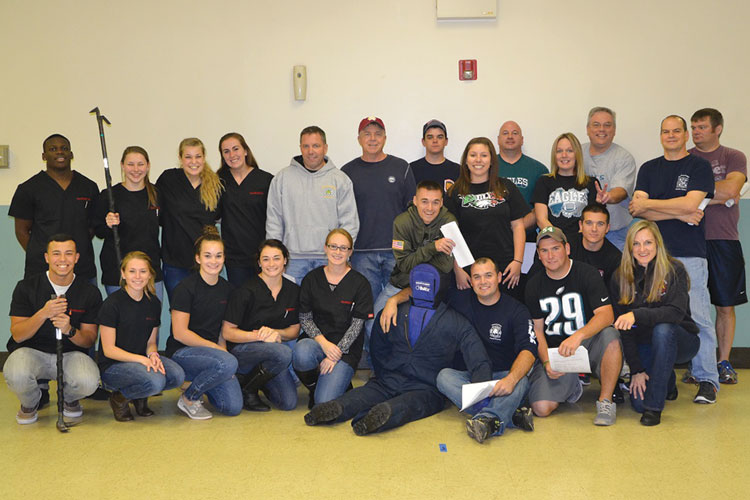
Cardiovascular disease remains the number-one cause of death in the United States and the leading cause of line-of-duty deaths for firefighters. Years of clinical exercise research have proven that any amount of physical activity is good for overall health, is good for the heart, can reduce blood pressure levels, and improves blood vessel health.1-3 Also, firefighting is a dangerous occupation because of its many physical and physiological demands.4
 (1) Members of the Limerick (PA) Fire Company (LFC) and HEART lab research assistants, who took part in the fitness circuit test conducted at LFC’s Station #54. (Photos by Dori-Ann Miles.) (1) Members of the Limerick (PA) Fire Company (LFC) and HEART lab research assistants, who took part in the fitness circuit test conducted at LFC’s Station #54. (Photos by Dori-Ann Miles.) |
Physically, firefighting requires muscular strength, aerobic endurance, balance, and coordination. Physiologically, firefighting taxes the cardiovascular (i.e., the heart and lungs), the musculoskeletal (i.e., the muscles and bones), and the thermoregulatory (i.e., temperature control) systems. Lack of physical training or improper types of exercise increase fatigue and affect performance, which can increase the risk of injury on the fireground. Research in healthy nonfirefighters has proven that even as little as four weeks of exercise can lower systolic blood pressure by about eight to 10 millimeters of mercury (mmHg), and the exercise can be as simple as going out for a good brisk walk.5 Physical activity increases the amount of blood circulating; this improves blood vessel health and function. People who exercise regularly have more flexible blood vessels and improved blood flow. Therefore, during periods of high stress (like fire operations), those with healthier blood vessels and a lower blood pressure will respond better and are less likely to have a cardiac incident. The problem is that many volunteer firefighters do not exercise regularly; are overweight; are smokers; and, therefore, are at increased risk for cardiac incidents.
Motivation to Exercise
Surprisingly, firefighters know they need to exercise to improve their health and reduce the risk of cardiac incidents, but many choose not to. Motivation to exercise is critical. We need to motivate firefighters to exercise and to keep exercising. Being healthier is important for firefighters because every time they are called into action, they must perform to their best ability while working under extreme conditions. According to the Unifying Model of Psychological Preparation for Peak Performance, an individual who performs under extreme conditions is a multidimensional being who is composed of a core foundation of personality and motivation, which is influenced externally by psychological and adversity-coping skills.6 Not only does this relationship among foundation, coping, environmental influences, and psychological skills play a large role in how firefighters respond to stressful situations, but it also affects how they value exercise.
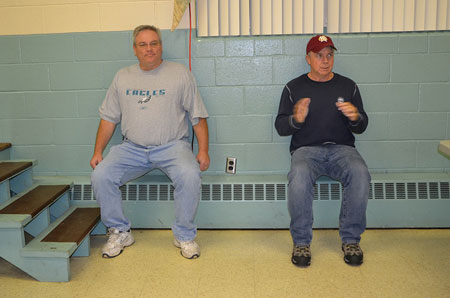 |
| (2) LFC President and former Chief Tom Walters (left) and LFC Chief Ken Shuler perform the wall sit. |
Exercise psychology attempts to explain reasons of behavior in relation to activity. (6) There is no doubt that volunteer firefighters are determined and achievement-oriented. The mere fact that they volunteer to run into burning buildings, rescue victims from accidents, and willingly place themselves in danger proves this. As exercise physiologists, we need to explore how to direct this commitment-driven personality into motivation to exercise and goals for health and fitness. Some studies have highlighted the importance of coaching and supervision to motivate firefighters. They have shown that exercise in groups improves fitness and increases enthusiasm more than exercising alone.7,8 Having specific goals is also important to exercise motivation. When a person is working toward a goal, he has a purpose. For example, later in this article, we will discuss how we used a fitness challenge between two neighboring fire departments as a means of motivation for the crew to exercise. Motivation to exercise is one very important area that you need to address with clinical research studies. Having this evidence will help firefighters value exercise and develop healthy exercise habits.
Existing Exercise Research
The questions that are always asked about exercise include the following: “How should I exercise?” and “What type of exercise is best?” Some research in firefighters has found that exercise programs that relate to job performance and that mimic the physiological response to real fireground tasks can improve cardiovascular health and reduce psychological stress. Conventionally, firefighter exercise programs have focused on cardiovascular endurance and muscular strength. For example, one study found that job performance in full turnout gear could be related to fitness measures of muscular strength, local muscular endurance, and anaerobic endurance.9 It has also been shown that the physiological responses to a fire suppression drill are similar to an exercise circuit workout.10
Exercise studies in career firefighters have shown promising results for improving physical fitness and fireground performance. One study of rookie firefighters found that exercise increased muscle, decreased fat, and improved endurance and flexibility.11 Also, improvements in body composition, strength, and performance in fireground tasks have been reported in other studies of paid firefighters.12, 13 In one study, health improved with a tactical circuit training program that increased in intensity every four weeks. For the first four weeks, paid firefighters started working out in their regular gym clothes; for the next four weeks, they wore self-contained breathing apparatus (SCBA); and for the final four weeks, they wore structural firefighting gear and SCBA. (7) Despite all of this, very little actual research exists for volunteer firefighters.
 |
| (3) LFC Battalion Chief Scott Miles (front) and Firefighter Tyler Miles perform the plank pose. |
Ultimately, a lack of physical activity remains a problem in the fire service. This problem is compounded by the fact that volunteer firefighters comprise about 70 percent of all firefighters in the United States. Volunteer fire departments do not require having established fitness programs. The National Fire Protection Association recognizes the importance of exercise training and recommends that firefighters participate in exercise programs, yet it is the responsibility of each fire station to implement a program.14
For example, a recent National Institute for Occupational Safety and Health report, which investigated cardiac deaths in firefighters, found that out of the 440 firefighter fatalities, 39 percent of those affected fire departments offered a fitness program and only eight percent of the departments required participation.15 So, we need to find ways to get firefighters exercising, to keep them exercising, and to get them to enjoy exercise.
Firefighter Fitness Challenge
Recently, our lab designed a four-week functional fitness circuit workout program for volunteer firefighters. To increase motivation, we challenged two fire departments from neighboring counties in Pennsylvania to complete the four-week exercise program and see who had the greatest improvement in fitness. The winner of the challenge would receive a halligan bar.
The two fire departments tested were the Limerick (PA) Fire Company (LFC) (photo 1) in Montgomery County and the East Brandywine Fire Company (EBFC) in Chester County. The two stations are about 25 miles apart and do not run any fire calls together. The LFC study was held at its Station #54 and the EBFC study was held at its Station #49. EBFC Chief John Edwards said, “Physical fitness is the greatest weakness on the fireground in today’s fire service. This study and other fitness initiatives are the start of changing that.”
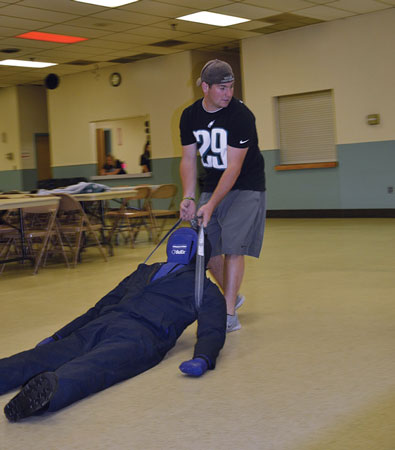 |
| (4) LFC Firefighter Rickey Shuler at the rescue dummy drag station. |
For the fitness challenge, volunteer firefighters from both companies were instructed to complete the four-week functional fitness circuit, three times through each of the six workout stations, three times a week. They were also instructed to maintain their current workout routine (if they were already exercising). The circuit included three-minute stair climbs, a plank pose (photo 3), a single-leg balance holding a fireground tool, and three different weighted carry exercises. The volunteer firefighters could use extrication tools, hose, or actual weight plates for the weighted-carry exercise stations.
As mentioned above, the six-station exercise circuit was to be done three times a week. Firefighters were to complete all six stations and go through the entire circuit a full three times. The entire workout session lasted between 30 and 45 minutes (depending on length of rest between stations and circuit rounds). The six stations included the following:
- Unsteady carry. Firefighters carried roughly 40 pounds (an extrication tool or weights) while walking for 100 feet.
- Stairway climb. Firefighters continuously climbed up and down the stairs for three minutes, either walking or running. They were instructed to move at their own pace as long as they kept moving, and they were allowed to start out faster and slow down throughout the three minutes.
- Plank pose. Firefighters had to hold a plank pose for 45 seconds.
- Weighted carry. Firefighters carried roughly 20 pounds of fireground tools or weights while walking very fast for 100 feet.
- Single-leg stands. Firefighters were instructed to stand on one leg as long as possible and then stand on the other leg. Many of them timed this station so that they could track their progress.
- Stairway carry. Firefighters carried 15 to 20 pounds of fireground tool or weights up and down 30 stairs or up and down a ladder.
As part of the research study, at the start and conclusion of the four-week fitness program, firefighters underwent fasted and fitness testing. Fasted testing included measurements of blood pressure, blood lipids, and body composition. Fitness testing included a two-minute stair climb, a wall sit (photo 2), a plank pose, a single-leg balance test, stair sprints, and a rescue dummy drag (photos 4-6). During the fitness intervention, we individually checked in with participants weekly to monitor the exercise, track their adherence to the program, and increase motivation by accountability.
Twenty-nine firefighters participated in the challenge, with an impressive 98-percent adherence to the exercise program. Motivation was very high. We found improvement in all fitness variables as well as improvement in blood pressure, blood lipids, and body composition at the conclusion of the intervention. Blood pressure dropped by four percent, triglycerides decreased by 17 percent, total cholesterol decreased by one percent, and high-density lipoprotein levels increased by two percent. Additionally, we found a four-percent decrease in body fat.
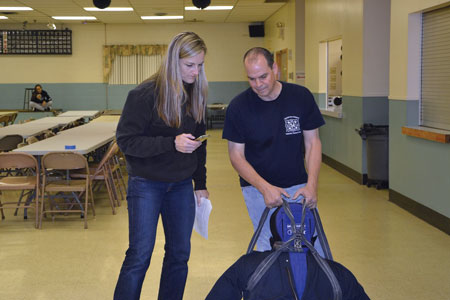 |
| (5) Deborah Feairheller with LFC Battalion Chief Scott Miles. |
This study showed scientific evidence that a terrific exercise program model that any fire department can use will increase morale among crews. The fact that the workout program was only four weeks long gave us the chance to see how much health and fitness improved in all of the volunteer firefighters in only these four weeks. The challenge gave the crews motivation to exercise, to get healthier, and to “beat” another crew at the fitness improvements. It was a close competition; in the end, the LFC won the fitness challenge.
This contest is a great way to jumpstart a fire department’s fitness program. LMC Chief Ken Shuler said, “It is a great feeling to pull into the station and see members running around the station with gear on, running the stairs with SCBA, dragging a rescue dummy around our social hall, and more.” He also stated, “The study ended, and our members were surprised and pleased with their improvement in just a few weeks. Of course, they were happy that they won the challenge. More important is that our members are now exercising more, are watching what they are eating, and are in the process of planning an in-house fitness room at the station.”
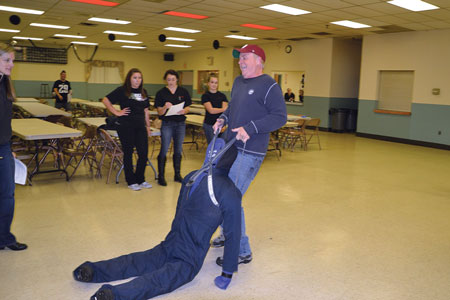 |
| (6) LFC Chief Ken Shuler doing the rescue dummy pull. |
Our research study proves the health benefits that only four weeks of exercise can have, and our study proved how motivated the crews were to compete with another department. There are many different functional fitness programs available to firefighters today. Some of them include the National Fallen Firefighters Foundation, the International Association of Fire Fighters, the National Interagency Fire Center FireFit program, and Firefighter Fitness Online. So, use this exercise incentive idea. Go out, find a neighboring fire department, and challenge the members to four weeks of exercise. Your crew will reap the rewards!
If you are interested in details on the workout program, contact Deborah Feairheller at dfeairheller@ursinus.edu.
Authors’ note: We would like to thank the volunteer firefighters of the LFC and the EBFC for their participation in the research study.
References
1. Chobanian AV, Bakris GL, Black HE, et al. The Seventh Report of the Joint National Committee on Prevention, Detection, Evaluation, and Treatment of High Blood Pressure: The JNC 7 report. JAMA 2003; 289(19): 2560-2572.
2. Pescatello LS, Franklin BA, Fagard R, et al. American College of Sports Medicine position stand. Exercise and hypertension. Medicine & Science in Sports & Exercise 2004; 36(3): 533-553.
3. Wallace, JP. Exercise in hypertension. A clinical review. Sports Med 2003; 33(8): 585-598.
4. Smith, DL. Firefighter fitness: Improving performance and preventing injuries and fatalities. Current Sports Medicine Reports 2011; 10(3): 167-172.
5. Cornelissen, VA and Smart, NA. Exercise training for blood pressure: A systematic review and meta-analysis. Journal of the American Heart Association 2014; 2: e004473.
6. Hardy L, Jones G, and Gould D. Understanding psychological preparation for sport: Theory and Practice of Elite Performers. Chichester, England: Wiley and Sons; 1996.
7. Pawlak R, Clasey JL, Palmer T, et al. The effect of a novel tactical training program on physical fitness and occupational performance in firefighters. Journal of Strength and Conditioning Research 2015; 29(3): 578-588.
8. Beach TAC, Frost DM, McGill SM, et al. Physical fitness improvements and occupational low-back loading-an exercise intervention study with firefighters. Ergonomics 2014; 57(5): 744-763.
9. Rhea MR, Alvar BA, and Gray R. Physical fitness and job performance of firefighters. Journal of Strength and Conditioning Research 2004; 18(2): 348-352.
1 0. Abel MG, Mortara AJ, and Pettitt RW. Evaluation of circuit-training intensity for firefighters. Journal of Strength and Conditioning Research 2011; 29(10): 2895-2901.
11. Roberts MA, O’Dea J, Boyce A, et al. Fitness levels of firefighter recruits before and after a supervised exercised training program. Journal of Strength and Conditioning Research 2002; 16(2): 271-277.
12. McDonough SL, Phillips JS, and Twilbeck TJ. Determining best practices to reduce occupational health risks in firefighters. Journal of Strength and Conditioning Research 2015; 29(7): 2041-2044.
13. Peterson MD, Dodd DJ, Alvar BA, et al. Undulation training for development of hierarchal fitness and improved firefighter job performance. Journal of Strength and Conditioning Research 2008; 22(5): 1683-1695.
14. National Fire Protection Association. NFPA 1583. Standard on health-related fitness programs for firefighters. Quincy, MA: 2008.
15. National Institute for Occupational Safety and Health. Preventing firefighter fatalities due to heart attacks and other sudden cardiovascular events. Department of Health and Human Services, Cincinnati, OH: 2007.
DEBORAH FEAIRHELLER, PhD, is a firefighter with the East Brandywine Fire Company in Chester County, Pennsylvania, and the Limerick and Collegeville Fire Companies in Montgomery County, Pennsylvania. She is also an assistant professor in the health and exercise physiology department at Ursinus College. Her research lab, the HEART (Hypertension and Endothelial function with Aerobic and Resistance Training) lab, examines the effect of lifestyle modifications on hypertension, ambulatory blood pressure, and vascular structure and function in firefighters.
JESSICA HILL is a doctorate of physical therapy student at Drexel University. She has worked as a research assistant in the HEART lab for the past two years. Hill was one of the lead investigators on the four-week exercise study.
Is There Ever Enough Time?
CAN MONEY MOTIVATE FIREFIGHTERS TO EXERCISE ?
The Professional Volunteer Fire Department, Part 8 – Physical Fitness
More Fire Engineering Issue Articles
Fire Engineering Archives

